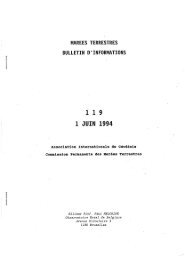marees terrestres bulletin d'informations - Université de la Polynésie ...
marees terrestres bulletin d'informations - Université de la Polynésie ...
marees terrestres bulletin d'informations - Université de la Polynésie ...
Create successful ePaper yourself
Turn your PDF publications into a flip-book with our unique Google optimized e-Paper software.
7 data sets (surface geopotential, surface pressure, 2 m temperature, humidity<br />
with 60/90 height levels, temperature with 60/90 height levels, geopotential with<br />
60/90 height levels, and barometric pressure with 60/90 height levels) from<br />
ECMWF Integrated Forecast System (IFS) daily analysis and error estimates are<br />
used in this investigation. The original data are re-sampled to a regu<strong>la</strong>r grid of<br />
0.5° × 0.5° and the coverage is 89.5° to - 89.5° in <strong>la</strong>titu<strong>de</strong> and 0° to 359.5° in<br />
longitu<strong>de</strong>. The sampling rate is 6 h. Until 31.01.2006, ECMWF provi<strong>de</strong>d data for<br />
60 height levels (about up to 64 km height), after this date the number of height<br />
levels was increased to 91 (about 80 km height). The gravity effects due to this<br />
modification amount to 8.42×10 − 4 µGal in a time span of 11 months. These<br />
effects are therefore small enough to be ignored in this study.<br />
2-2 The air <strong>de</strong>nsity distribution<br />
For the estimation of the atmospheric attraction term, the air <strong>de</strong>nsity<br />
distribution needs to be computed for each cell of air mass.<br />
The atmosphere is consi<strong>de</strong>red as a mixture of dry air and water vapor. By<br />
using the i<strong>de</strong>al gas equation the air <strong>de</strong>nsity ρ can be <strong>de</strong>rived from<br />
p<br />
ρ =<br />
(1),<br />
q<br />
RT( 1− q+ )<br />
ε<br />
where R is the gas constant for dry air (287.05 Jkg −1<br />
K −1 ), p, q, T are respectively<br />
barometric pressure, humidity, temperature taken from ECMWF data (from the<br />
Earth’s surface to 80 km height) and ε is the ratio of the gas constants for dry<br />
R<br />
air R and water vapour R v<br />
( ε = = 0.62197 ) . Fig. 1a shows the air <strong>de</strong>nsity<br />
R<br />
v<br />
distribution using (1) and ECMWF data for the example of Moxa station<br />
(Fig.3)(50.6447° N, 11.6156° E and a height of 455m) for the time span of one<br />
month and the vertical <strong>de</strong>nsity distribution <strong>de</strong>rived from the U.S. Standard<br />
Atmosphere 1976 (NASA,1976) and the well-known barometric formu<strong>la</strong> (2)<br />
g<br />
0<br />
−<br />
P0<br />
⎛ T0<br />
+ αz ⎞<br />
ρ(z)=<br />
Rα<br />
RT<br />
⎜<br />
Z<br />
T<br />
⎟ (2)<br />
⎝ 0 ⎠<br />
with T<br />
Z<br />
= T 0<br />
+ αz and α as the rate of temperature change with height from the<br />
US1976 standard atmosphere up to 84 km. P 0<br />
and T<br />
0<br />
are respectively surface<br />
pressure and temperature from ECMWF, T Z<br />
is temperature at height z, and g 0<br />
is the mean surface gravity value 9.80665 m/s 2 .



